The cold brings discomfort to most people. When the temperature of housing depends only on centralized heating, this unpleasant situation in the fall can last for several weeks, but installing a convector will help save the family from waiting for the batteries to run. He is able to perform the role of primary heating or auxiliary, when the temperature is not enough for comfort. There are several types of convectors with a dozen of characteristics, realizing that it will turn out to pick up the device most appropriate to the room served.
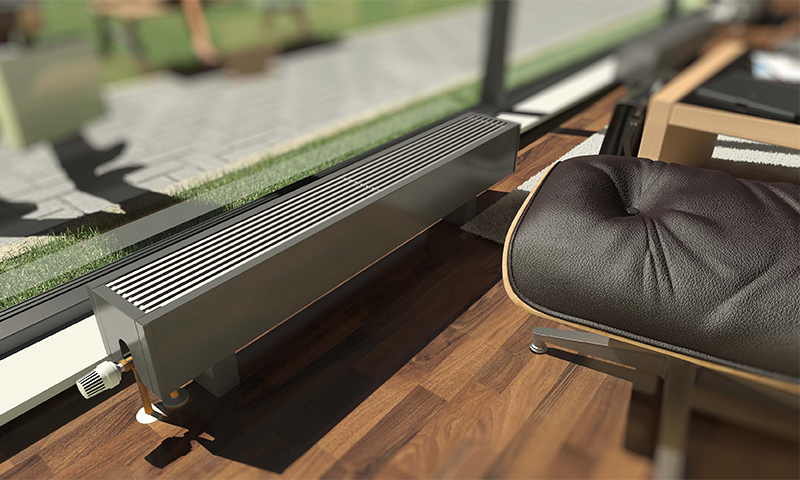
Content:
The best manufacturers of convectors - which company to choose
If you are too lazy to understand the device device and its key characteristics, then you can buy any convector from trusted companies:
- Atlantic;
- Electrolux;
- Ballu;
- Timberk;
- Scoole
Such heaters will last a very long time. But their capabilities are so diverse that it is worth reading an overview of the key characteristics and scope of specific models in our ranking of the best convectors. Here we will discuss the independent choice of a convector solely by its main parameters and their display in use.
The principle of operation and the device convector
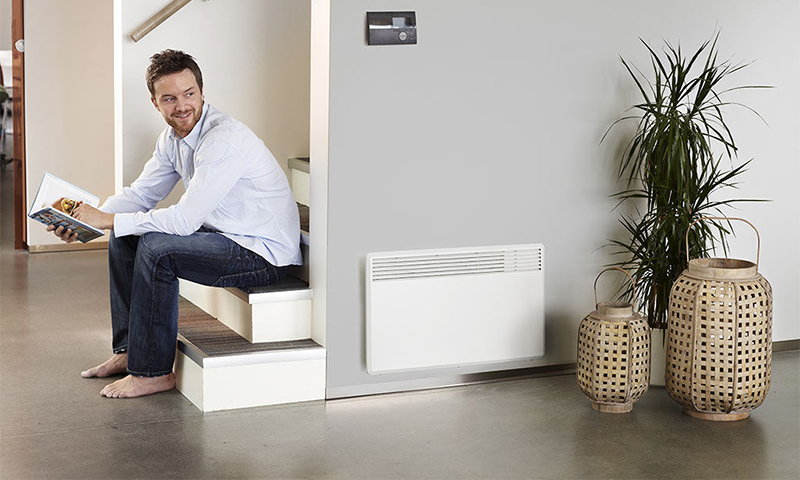
The device got its name not by chance. Convection involves the rapid transfer of thermal energy. Unlike a fireplace or oil heater, which heat the surrounding space along a decreasing radius (the farther from the heat source, the cooler), the convector acts on all the air in the room, triggering its circulation. So it turns out to evenly distribute heat throughout the room.
This is achieved by a rectangular housing with inlet and outlet openings. The heating element inside increases the temperature of the air, which, under the law of the law, rises up, being very light. The cold masses immediately draw inward in its place and the cycle is repeated. Invisible to the human eye in the room are constantly moving warm streams, warming the whole space.
One more difference of the convector is fast work. Unlike an oil radiator, it is not necessary to wait for the coolant and the body of the device to warm up in order to release heat. 60 seconds after the start of the heating element, it already acts on the air inside the body and starts its movement.
To ensure this activity, the device has the following elements:
1. Thermostat to adjust the climate;
2. Safety sensor;
3. A heating element;
4. Control board with buttons;
5. Thermal sensor;
6. Casing with lattice holes;
7. Mounts or tripod for installation.
In the case of using gas in the device are added:
1. Valves;
2. Fans;
3. Channel exhaust.
Thanks to simple work and simple installation, convectors are used for main or auxiliary heating in: private houses, apartments, offices, kindergartens, corridors, greenhouses, changing rooms.
Place them on the wall, in the floor, next to the sofas. The wheels on some models allow you to change the location on demand.
Their main advantages are:
1. Fast heating;
2. The maximum temperature of 60 degrees, leaving oxygen in the room intact;
3. Not dry air;
4. Uniform heating of the entire room;
5. Easy installation and use.
To run in a cold room, just press the button and set the thermostat to the maximum.After reaching a comfortable temperature, it is necessary to set an upper threshold that the device will maintain constantly.
Additional features allow you to customize other modes, so that the convector can turn on itself early in the morning, turn off at midnight when everyone is asleep in the heat, or maintain a minimum temperature and prevent plants and water from freezing in an unheated closed house.
Types of convectors
Electric
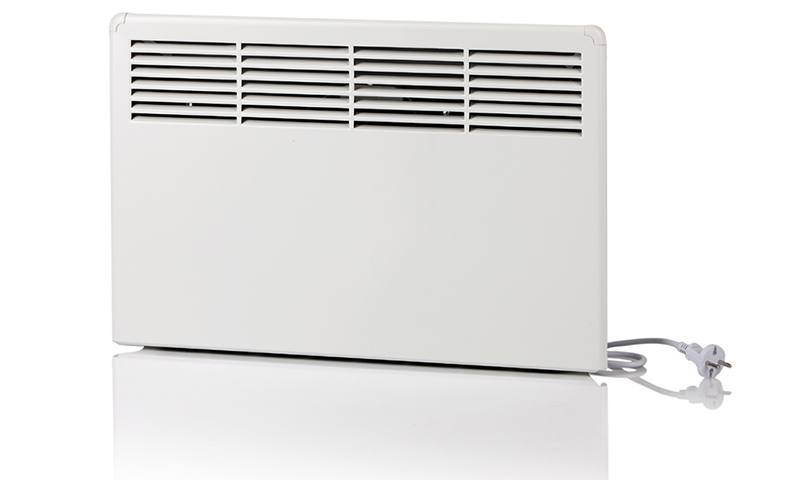
Are the most common among heating appliances and have a wide range of heated area. They have an affordable price and various customization options.
They are installed in children's rooms, bedrooms, offices and living rooms in order to maintain a comfortable temperature combined with centralized heating. Without the latter, the devices are able to heat the premises on their own, but with a large consumption of electricity.
Advantages:
- large selection by price;
- diverse power;
- programmable modes;
- installation on the wall or floor installation;
- fine adjustment of thermostats;
- wake-up and off timers;
- Efficiency of 90-95%;
- rapid heating to operating temperature;
- overheat protection.
Disadvantages:
- thermostat work associated with clicks;
- some models have a very simple design;
- high current consumption at maximum mode in high-power devices.
Gas
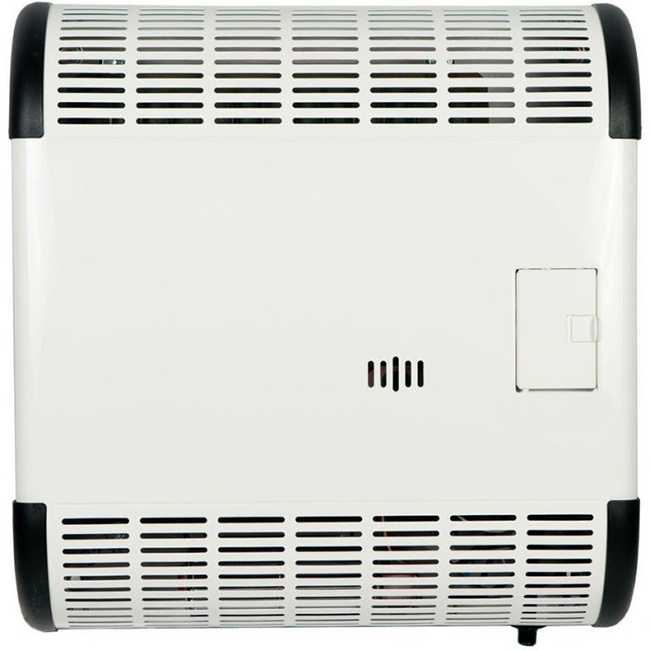
Here, heating is carried out by supplying blue fuel to the burner, which acts on the heat exchanger. The heated air comes out of the case, and in its place comes cold. To speed up the convection device is mounted fan.
In addition to working from a gas pipeline, such an apparatus is able to function from a cylinder. The main condition for operation is the presence of a chimney for removal of combustion products. Apply such convectors to the main heating in private houses or apartments.
Advantages:
- having installed in each room one device can be used as the main heating;
- no isolation of pipes around the house is required;
- work on the natural and liquefied gas;
- long service life;
- large heating area;
- low consumption;
- temperature adjustment from +13 to +40 degrees;
- secure fixing on the wall.
Disadvantages:
- installation of the chimney is required;
- high price.
Water
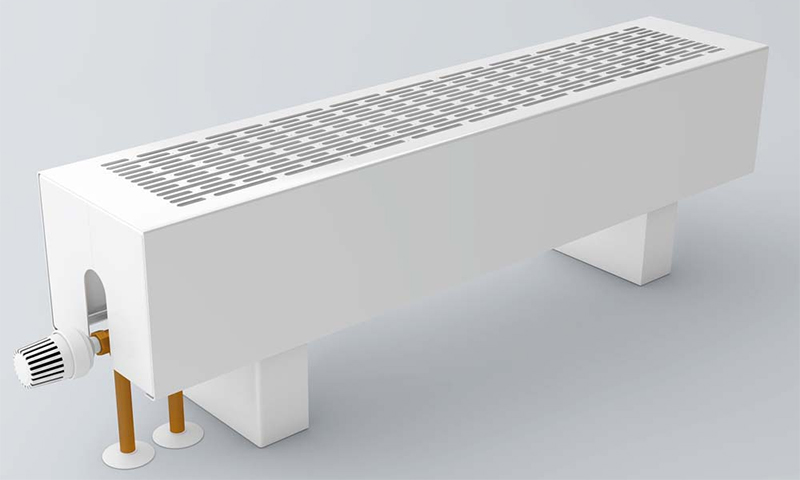
Water convectors operate from a heat transfer fluid and have in their device a network of grids with laid pipes, which ensure the rapid transfer of temperature from water to air. To speed up the effect they build in fans.
The main areas of use are corridors, panoramic windows, greenhouses in winter, swimming pools, shopping centers. Installation is carried out in the floor or window sill, where only the grille is flush with the floor.
The device has no heat source and is connected to the boiler or centralized heating.
Advantages:
- long service life;
- unpretentious design;
- the internal installation which is not taking away useful space indoors;
- does not spoil the standing furniture;
- eliminates condensation on the windows.
Disadvantages:
- separate boiler required;
- fast dustiness of internal elements;
- high price.
Convector selection options
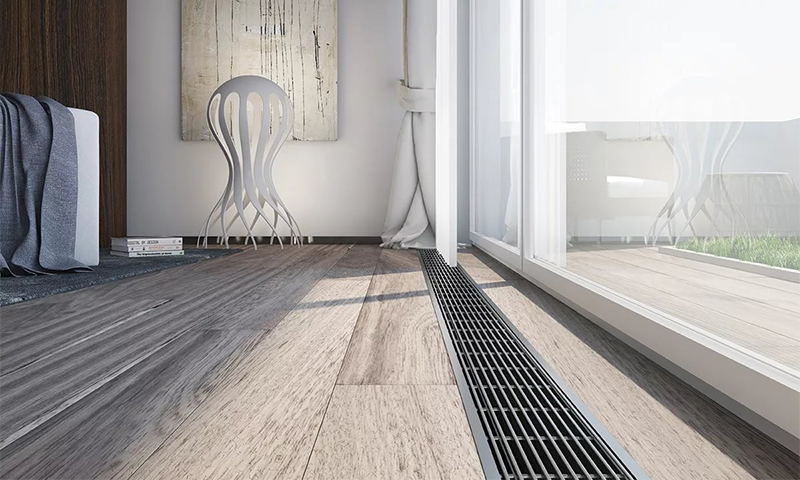
Power
This parameter varies from 0.5 to 9.6 kW. It should be taken into account by many factors:
1. The area of the heated room. If you buy a device designed for a large hall and heat a small nursery for them, you get an overpayment of funds and an untapped potential of the device working for a third of its strength. Conversely, a low-power convector in a spacious room will not be effective and coolness will be felt despite the maximum mode. This will lead to the rapid exhaustion of the resource equipment.
The power of the convector is calculated by the formula: 1 m2 = 100 watts. Therefore, for a small nursery for 5 m2 enough indicator 500 watts. In the hall of 20 m2 will need 2 kW, and for a spacious living room on 30 m2 at least 3 kW. But here plays a role and the quality of wall insulation, as well as the presence of other sources of heating.Therefore, with thin walls and rapid cooling of the room, in which there is no central heating, an additional supply of 50 W per each m2 will be required.
2. Power usage. The higher the indicator of the apparatus, the greater the cost will have to pay for electricity. So, in a children's room with a 500 W convector, if you turn it on every day for 5 hours, 75 kW will come out in a month. And with a device with a capacity of 2 kW, with the same mode of use, it will turn out 300 kW per month. And this is only one convector! Because of this, a family that wants to save money should not purchase a model of more than 1 kW.
3. Wiring Capabilities The more powerful the convector, the greater the load will create a current in the wires (they will heat up). For new apartments and houses it doesn’t matter in principle, but "stalin" and "Khrushchev" with aluminum wiring can not withstand. It is permissible to use devices with a capacity of not more than 2 kW, if this includes a refrigerator and a washing machine. But to stroke things at this moment may not work (knock out traffic jams).
Square
Manufacturers indicate the recommended area of heating in the characteristics of the convectors. It can be from 5 to 96 m2. But you should know that it is calculated with the condition when there are no other sources of heating, and the temperature from the device will fluctuate within 22-25 degrees, depending on the wall insulation and minimization of gaps (windows, doors, ceiling type).
1. For the living room, you can take the device based on a direct indication of the area in the passport.
2. For a nursery or bedroom, where you may want more heat, it is better to take the unit with a margin (for a room of 20 m2 to buy a convector designed for 25 m2). This will raise the temperature to 26-28 degrees.
3. In offices, on the contrary, the indicator is suitable with a slight lag from the size of the area in order to maintain a not hot climate of 20-22 degrees.
4. If the room has centralized heating, then it is not necessary to choose a model that exactly corresponds to the area, because these calculations were made without taking into account other sources of heating. Then you can take the device to 500-1000 W, which will allow you to raise the temperature by several degrees on a frosty day in a room of any size.
Type of attachment
On this depends the convenience of placement, occupied usable area, maneuverability and safety of the unit.
There are several basic features for installing a convector:
1. Wall - convenient for children's rooms and kitchen. Does not interfere under your feet and can not be knocked over.
2. Outdoor (on wheels or bracket) - often installed in the living room, bedroom. This is also practical for office units with partitions, where the heater can be installed next to the employee and his workplace. It is easy to take with him to any room in the house, but owners of large pets (big dog, raccoon) need to be careful not to overturn the body.
3. Recessed - mounted in the floor or windowsill under the panoramic windows, they are installed in greenhouses and swimming pools, shopping centers.
Thermostat
There are two types of thermostat:
1. Mechanical - is cheaper and its principle of operation is a thin plate that is sensitive to temperature changes. By turning the knob changes its location on the contacts. When it becomes warm and the set mode is reached, the plate is curved and the electrical circuit is opened. Cooling air over time returns it to its place and the cycle repeats.
2. Electronic - provides more accurate work. It will turn on and off exactly on the specified indicators. This is especially important for pharmacies, warehouses and winter gardens, where the safety of drugs and plants depends on the temperature accuracy.
Roll Over Protection
In some heaters, manufacturers embed a shutdown system when the body position changes. It works thanks to patch contacts, which provide current conductivity only when the unit is vertically stacked.If the housing falls, the terminals open and the convector de-energizes.
Otherwise, the device would continue to heat the floor (laminate, parquet, carpet), and closed openings for hot air would increase the temperature and, possibly, the fire.
A convector with such protection should be bought for those who have small children or pets who may overturn it during the game. It is also practical for workers in shifts, whose departure or arrival may be in the middle of the night in the dark, so as not to wake the rest, where it is easy to knock down equipment.
Arrangement of holes for convection
The slots at the top and bottom of the case provide fast air circulation through the heating element of the device.
They are:
1. On the top panel;
2. On the side;
3. Front;
4. On the sloping part of the front side.
It is worth considering that the holes in the top cover have a high permeability for turning air masses, but this also opens up easy access to dust settling on the heating element and the smell of burning with each switch.
If you put such a device close under the wall, it will lead to fading of the color of the wallpaper. This option is more suitable for placement in the middle of the room. In the nursery and bedroom for wall mounting, it is better to choose models with slots on the vertical front wall of the case.
Dimensions
Convectors are made in square or rectangular shape. The longest side is the horizontal size, which can be from 300 to 2040 mm. It is worth considering to determine the installation site. If the heater will occupy the floor of the room in the middle, as a fence, it will be extremely inconvenient.
1. As an additional heating for a small kitchen, it is better to choose convectors up to 500 mm in length, which will fit under the table.
2. Hall and bedroom are equipped with models of 600-800 mm.
3. Devices from 1000 mm are installed only if they play the role of the main heating. Their installation is carried out under the window, instead of the registers of the water system.
Weight
The weight of the convector varies from 2 to 33 kg.
1. In the case of a floor installation, it is better to choose equipment for 3-5 kg, which is harder to knock over than lightweight appliances. It will not be so difficult to move the heater around the room or transport it to the next room.
2. When installing an electrical device on a wall, it is advisable to choose a mass of up to 7-8 kg in order to secure the device on the dowel.
3. Heavy gas models can weigh from 12 to 27 kg and are mounted on an anchor. Here it is important to take into account the thickness of the wall and its material, so that the mount does not loosen over time.
Housing protection degree
Manufacturers indicate on the case of the letter IP and numbers indicating the security of the device from external influence.
The first digit is most often “2”, which means that it is impossible to stick fingers into it or damage the internal structure with objects more than 12.5 mm in diameter. But the second figure varies from 1 to 4, which affects the possibility of using a convector near water.
1. The IP 21-22 models will be suitable for dry rooms: bedroom, nursery, hall.
2. The kitchen is better to buy a device with an indicator of IP 23, which is slightly protected from the angle of moisture.
3. To warm the bathroom is to look for a device with a characteristic of IP 24.
Set for liquefied gas
Buying a model working on blue fuel should worry about the presence of an adapter for the cylinder. This is useful in case of gas shutdown in the system so that the house is not left without heating.
In another way, it will be possible to heat a remote building that is not connected to the gas pipeline. This is beneficial for villas, private houses, forest buildings.
Built-in fan
Despite the independent natural circulation of air masses in the device, the presence of a fan significantly speeds up the heat exchange process and contributes to better maintenance of the premises, even if the power of the apparatus is less than the available area.
A model with a fan should be looked for with elongated rectangular rooms with placement of the device on the end wall.Especially important is the fan in the water convectors under the panoramic windows, which will inject air and protect against condensation on the panes.
Additional functions
Ease of use and comfort depend on the breadth of advanced settings and functions. Here are some features of modern convectors that are worth paying attention to in certain situations:
1. Ionization of air. The device cleans air masses from fungi and bacteria, and also fills them with useful ions, making the composition close to the forest air. This is especially useful for allergies, asthmatics and children in their bedrooms.
2. Timer. Allows you to program the inclusion of 30-60 minutes before the usual time of awakening of the family. Setting the device to turn off at night, after everyone is asleep in the heat, you do not need to get up and stop the device. This is great for people with busy schedules.
3. Mode "comfort" and "economy". The first is set by the user and stored in the device’s memory. When enabled, automatically brings to this temperature and holds it. The second is capable of supporting the work of the apparatus 3 degrees below the “comfort” in order to create a pleasant climate and spare the family budget. Functions save you from everyday adjustment of the device, which is convenient for working people or busy moms with babies.
4. Anti-frosting mode. The presence of such a regime is useful for owners of houses and apartments without centralized heating. When residents leave for a week, the convector can be disconnected from the main modes, but it will automatically maintain a temperature of 5-7 degrees, so as not to freeze and be ready for a quick start upon return of the owners.
Which convector to choose

1. For the dacha, as the main heating without decoupling the pipes, a gas convector with a capacity of 6.9 kW, wall mount, designed for an area of 70 m2, with a mechanical thermostat and a fan, is suitable. The case length of 800 mm will be easy to place on any wall, and for installation 20-23 kg anchor is required.
2. For a children's room and auxiliary heating, a model of 1 kW designed for 10 m2 and weighing 2.8 kg with wall mounting is enough to avoid tipping. An air ionization function and a timer will be useful.
3. In the pool or winter garden it is practical to install a water-type convector under the windows, which is sunk into the floor. Power rating from 0.5 kW, weighing 8 kg, working in tandem with the boiler. Greater heat transfer can be achieved from a model with a fan. The length of 1200-1500 mm is selected on the window.
4. To have a comfortable climate in the bathroom, an electric model with a small power of 0.5 kW is required, with an indicator of up to 5 m2 and a weight of 3.3 kg, placed on the wall so as not to interfere in a small room. Particular attention is paid to the degree of protection IP24 and electronic thermostat.
How much is a convector
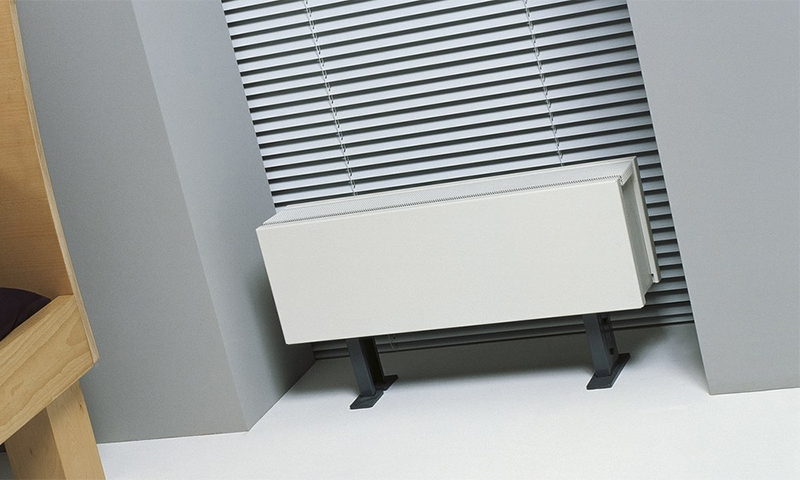
1. A gas-type heating device to the country costs 20000-33000 rubles.
2. An electric model for a bedroom and a nursery will cost 2200-5000 rubles.
3. Water convector with a fan for panoramic windows bought for 12000-25000 rubles.
4. Heated bathroom needs a device for 7000-10000 rubles.
It will be interesting to friends too










